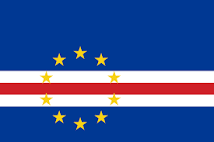Population: Estimate 543.000
Area: 4 033 km²
Capital City: Praia
In ancient times these islands were referred to as “the Islands of the Blessed” or the “Fortunate Isles”. Located 570 kilometres (350 mi) west of the Cape Verde Peninsula in West Africa, the islands cover a combined area of slightly over 4,000 square kilometres (1,500 sq mi). The Cape Verde archipelago was uninhabited until the 15th century, when Portuguese explorers discovered and colonized the islands, establishing the first European settlement in the tropics. Ideally located for the Atlantic slave trade, the islands grew prosperous throughout the 16th and 17th centuries, attracting merchants, privateers, and pirates. The end of slavery in the 19th century led to economic decline and emigration. Cape Verde gradually recovered as an important commercial center and stopover for shipping routes. Incorporated as an overseas department of Portugal in 1951, the islands continued to campaign for independence, which was peacefully achieved in 1975. Since the early 1990s, Cape Verde has been a stable representative democracy, and remains one of the most developed and democratic countries in Africa. Lacking natural resources, its developing economy is mostly service-oriented, with a growing focus on tourism and foreign investment. Its population of around 540,000 is mostly of mixed European, Moorish, Arab and African heritage, and predominantly Roman Catholic, reflecting the legacy of Portuguese rule. A sizeable diaspora community exists across the world, slightly outnumbering inhabitants on the islands. Historically, the name “Cape Verde” has been used in English for the archipelago and, since independence in 1975, for the country. In 2013, the Cape Verdean government determined that the Portuguese designation Cabo Verde would henceforth be used for official purposes, such as at the United Nations, even in English contexts. Cape Verde is a member of the African Union.
Currency
The escudo is the currency of the Republic of Cape Verde. One escudo is subdivided into one hundred centavos. Amounts are generally written by using the cifrão as the decimal separator, such as 2000 for 20 escudos, or 1.00000 for 1000.
Biome
Cape Verde’s isolation has resulted in the islands having a number of endemic species, particularly birds and reptiles, many of which are endangered by human development. Endemic birds include Alexander’s swift (Apus alexandri), Bourne’s heron (Ardea purpurea bournei), the Raso lark (Alauda razae), the Cape Verde warbler (Acrocephalus brevipennis), and the Iago sparrow (Passer iagoensis). The islands are also an important breeding area for seabirds including the Cape Verde shearwater. Reptiles include the Cape Verde giant gecko (Tarentola gigas).
Climate
Cape Verde’s climate is milder than that of the African mainland, because the surrounding sea moderates temperatures on the islands and cold Atlantic currents produce an arid atmosphere around the archipelago. Conversely, the islands do not receive the upwellings (cold streams) that affect the West African coast, so the air temperature is cooler than in Senegal, but the sea is warmer, because the orographic relief of some islands, such as Santiago with steep mountains, cover it with rich woods and luxuriant vegetation where the humid air condenses and soak the plants, rocks, soil, logs, moss, etc. On the higher islands and somewhat wetter islands, exclusively in mountainous areas, like Santo Antão island, the climate is suitable for the development of dry monsoon forest, and laurel forest as this vegetation Average daily high temperatures range from 26 °C (79 °F) in February to 31 °C (87.8 °F) in September. Cape Verde is part of the Sahelian arid belt, with nothing like the rainfall levels of nearby West Africa. It rains irregularly between August and October, with frequent brief heavy downpours. A desert is usually defined as terrain that receives less than 250 mm (9.8 in) of annual rainfall. Sal’s total of (145 mm (5.7 in)) confirms this classification. Most of the year’s rain falls in September.
Crime
Theft and burglary are common in Cape Verde especially in crowds, such as market places, festivals, and celebrations. Often the perpetrators of these crimes are gangs of street children. Murders are concentrated in the major population centres of Praia and Mindelo.
Culture
The culture of Cape Verde is characterized by a mixture of European and African elements. This is not a sum of two cultures living side by side, but a new culture resulting from an exchange that began in the 15th century. The Cape Verdean case may be situated in the common context of African nations, in which elites, who questioned European racial and cultural superiority and who in some cases undertook a long armed struggle against European imperialism and national liberation, use the rule of Western codes as the main instrument of internal domination. Cape Verdean social and cultural patterns are similar to those of rural Portugal. Football games and church activities are typical sources of social interaction and entertainment. The traditional walk around the praça (town square) to meet friends is practiced regularly in Cape Verde towns.
Economy
Cape Verde’s notable economic growth and improvement in living conditions despite a lack of natural resources has garnered international recognition, with other countries and international organizations often providing development aid. Since 2007, the UN has classified it as a developing nation rather than a least developed country. Cape Verde has few natural resources. Only five of the ten main islands (Santiago, Santo Antão, São Nicolau, Fogo, and Brava) normally support significant agricultural production, and over 90% of all food consumed in Cape Verde is imported. Mineral resources include salt, pozzolana (a volcanic rock used in cement production), and limestone. Its small number of wineries making Portuguese-style wines have traditionally focused on the domestic market, but have recently met with some international acclaim. A number of wine tours of Cape Verde’s various microclimates began to be offered in spring 2010 and can be arranged through the tourism office. The economy of Cape Verde is service-oriented, with commerce, transport, and public services accounting for more than 70% of GDP. Although nearly 35% of the population lives in rural areas, agriculture and fishing contribute only about 9% of GDP. Light manufacturing accounts for most of the remainder. Fish and shellfish are plentiful, and small quantities are exported. Cape Verde has cold storage and freezing% facilities and fish processingplants in Mindelo, Praia, and on Sal. Expatriate Cape Verdeans contribute an amount estimated at about 20 of GDP to the domestic economy through remittances. In spite of having few natural resources and being semi-desert, the country boasts the highest living standards in the region, and has attracted thousands of immigrants of different nationalities.
Ethnic groups
The Cape Verde archipelago was uninhabited when the Portuguese discovered it in 1456. The modern population of Cape Verde descends from the mixture of European settlers and African slaves who were brought to the islands to work on Portuguese plantations. Most Cape Verdeans are therefore mulattos, also called mestiços in Portuguese. Another term is creole, meaning those of mixed native-born African and native-born European descent. European input included Spaniards and Italian seamen who were granted land by the Portuguese Empire, followed by Portuguese settlers and exiles, as well as Portuguese Muslims (ethnic Moors) and Portuguese Jews (ethnic Sephardim), both of these religious groups were victims of the Inquisition. Other immigrants came from places such as the Netherlands, France, Britain, the Arab countries (especially Lebanon and Morocco), China (especially from Macau), India, Indonesia, South America, and North America (including people of Portuguese and African descent) and were absorbed into the mestiço population.
Foreign relations
Cape Verde follows a policy of nonalignment and seeks cooperative relations with all friendly states. Angola, Brazil, China, Libya, Cuba, France, Germany, Portugal, Spain, Senegal, Russia, Luxembourg, and the United States maintain embassies in Praia. Cape Verde is actively interested in foreign affairs, especially in Africa. Cape Verde has bilateral relations with some Lusophone nations and holds membership in a number of international organisations. It also participates in most international conferences on economic and political issues. Since 2007, Cape Verde has a special partnership status with the EU, under the Cotonou Agreement, and might apply for special membership, even because the Cape Verdean escudo, the country’s currency, is indexed to the Euro. In 2011 Cape Verde ratified the Rome Statute of the International Criminal Court.
Health
Language Health
Cape Verde’s official language is Portuguese. It is the language of instruction and government. It is also used in newspapers, television, and radio. Cape Verdean Creole is used colloquially and is the mother tongue of virtually all Cape Verdeans. The national constitution calls for the measures to give it parity with Portuguese. Cape Verdean Creole or Kriolu is a dialect continuum of a Portuguese-based creole. There is a substantial body of literature in Creole, especially in the Santiago Creole and the São Vicente Creole. Creole has been gaining prestige since the nation’s independence from Portugal. The differences between the forms of the language within the islands have been a major obstacle in the way of standardization of the language. Some people have advocated the development of two standards: a North (Barlavento) standard, centered on the São Vicente Creole, and a South (Sotavento) standard, centered on the Santiago Creole. Manuel Veiga, PhD, a linguist and Minister of Culture of Cape Verde, is the premier proponent of Kriolu’s officialization and standardization.
Physical geography and geology
Geologically, the islands, covering a combined area of slightly over 4,033 square kilometres (1,557 square miles), are principally composed of igneous rocks, with volcanic structures and pyroclastic debris comprising the majority of the archipelago’s total volume. The volcanic and plutonic rocks are distinctly basic; the archipelago is a soda-alkaline petrographic province, with a petrologic succession similar to that found in other Macaronesian islands. Magnetic anomalies identified in the vicinity of the archipelago indicate that the structures forming the islands date back 125–150 million years: the islands themselves date from 8 million (in the west) to 20 million years (in the east). The oldest exposed rocks occurred on Maio and northern peninsula of Santiago and are 128–131 million year old pillow lavas. The first stage of volcanism in the islands began in the early Miocene, and reached its peak at the end of this period, when the islands reached their maximum sizes. Historical volcanism (within human settlement) has been restricted to the island of Fogo.
Politics
Cape Verde is a stable semi-presidential representative democratic republic. It is among the most democratic nations in Africa, ranking 23rd position in the world, according to the 2016 Democracy Index. The constitution — adopted in 1980 and revised in 1992, 1995 and 1999 — defines the basic principles of its government. The president is the head of state and is elected by popular vote for a 5-year term. The prime minister is the head of government and proposes other ministers and secretaries of state. The prime minister is nominated by the National Assembly and appointed by the president. Members of the National Assembly are elected by popular vote for 5-year terms. Three parties now hold seats in the National Assembly — MPD (36), PAICV (25) and the Cape Verdean Independent Democratic Union (UCID) (3). The judicial system consists of a Supreme Court of Justice — whose members are appointed by the president, the National Assembly, and the Board of the Judiciary — and regional courts. Separate courts hear civil, constitutional, and criminal cases. Appeal is to the Supreme Court.
Religion
Around 95% of the population are Christian. More than 85% of the population was nominally Roman Catholic in 2007. For a minority of the population, Catholicism is syncretized with African influences. The largest Protestant denomination is the Church of the Nazarene; other groups include the Seventh-day Adventist Church, The Church of Jesus Christ of Latter-day Saints, the Assemblies of God, the Universal Church of the Kingdom of God, and other Pentecostal and evangelical groups. There is a small Muslim community. There were Jewish settlements on several islands. The number of atheists is estimated at less than 1% of the population.
Tourism
Transport
Ports
There are four international ports: Mindelo, São Vicente; Praia, Santiago; Palmeira, Sal; and Sal Rei, Boa Vista. Mindelo on São Vicente is the main port for cruise liners and the terminus for the ferry service to Santo Antão. Praia on Santiago is a main hub for local ferry services to other islands. Palmeira on Sal supplies fuel for the main airport on the island, Amílcar Cabral International Airport, and is important for the hotel construction taking place on the island. Porto Novo on Santo Antão is the only source for imports and exports of produce from the island as well as passenger traffic since the closure of the airstrip at Ponta do Sol. There are smaller harbors, essentially single jetties at Tarrafal on São Nicolau, Sal Rei on Boa Vista, Vila do Maio (Porto Inglês) on Maio, São Filipe on Fogo and Furna on Brava. These act as terminals for the inter-island ferry services, which carry both freight and passengers. The pier at Santa Maria on Sal used by both fishing and dive boats has been rehabilitated.














